
The goals of todays drawings were to first grab a piece of charcoal and spread the whole piece of white paper with the charcoal. Following, you had to grab a piece of paper towel and wipe it against the paper, so that the charcoal that was drawn on the paper turned lighter. Then, we looked at different figures arranged in a certain way and we erased to make the shape of each figure. For example, since there was a pot in the center of all the objects and erased in the center of the paper so that there was a good balance between everything. After erasing, we could use pencils or certain types of crayons to make the erase spots more detailed. However, after looking at the other students drawings I realized I could have done a better job through out the process. One example is that I could have looked more at all the figures and how were they arranged before going right into drawing because I didn't have enough room to add everything. Also, I should have noticed more of the colors and lighting because other objects were darker than others and some were transparent. Next time, I know to look more at all the figures and less at what I am drawing!






